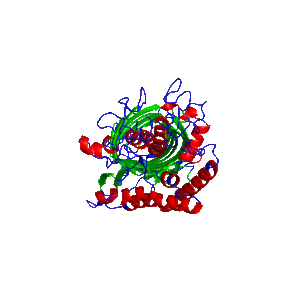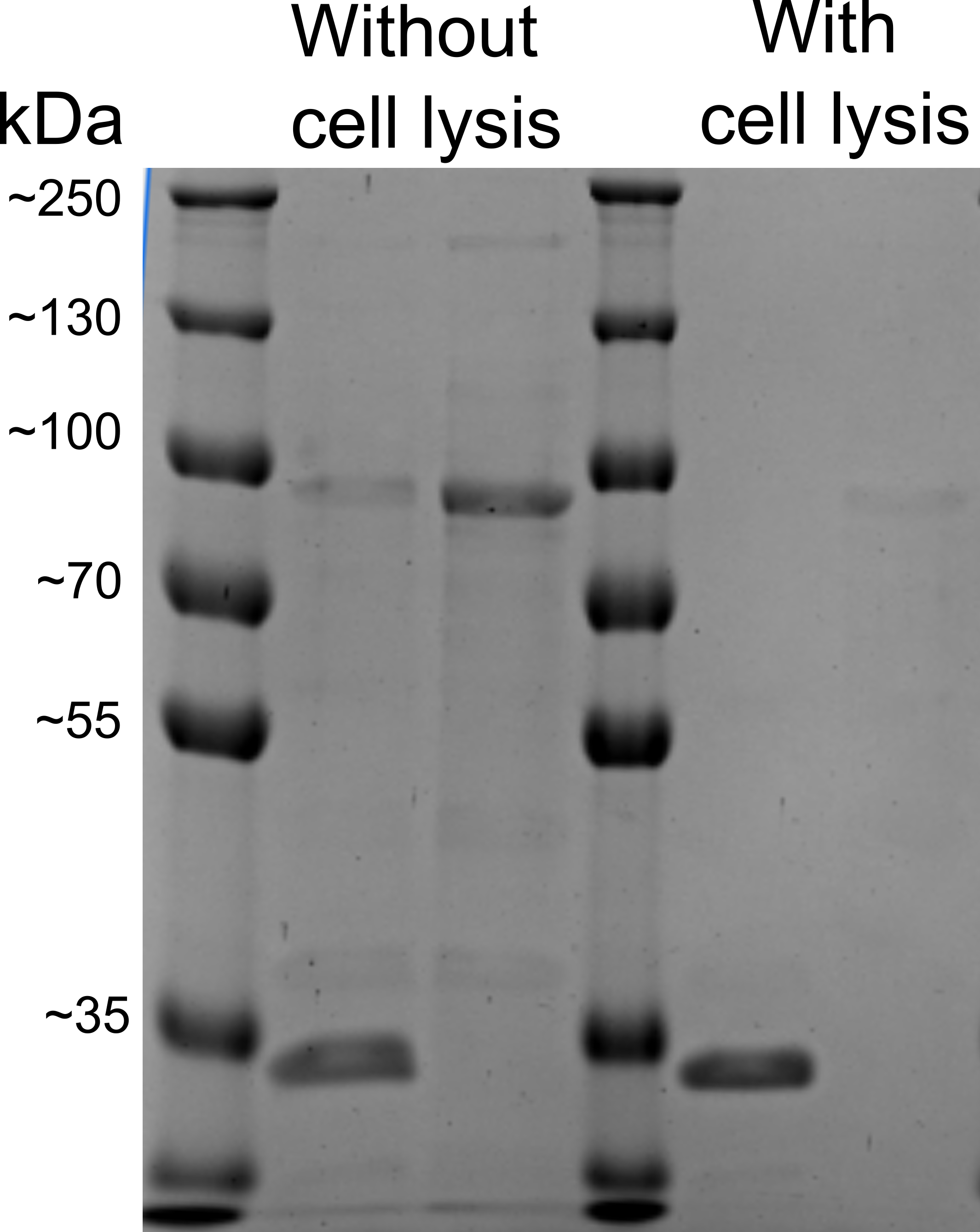Part:BBa_K2694001
EstA from Pseudomonas aeruginosa
This esterase is an enzyme from Pseudomonas aeruginosa. The function of esterase is to cleave ester bonds, such as those found in triglycerides. This protein was used by the 2018 NDC-HighRiverAB team to create the composite part BBa_K2694000.
Contribution by Vilnius-Lithuania 2022
Introduction
Vilnius-Lithuania Igem 2022 project NanoFind was working to create an easily accessible nanoplastic detection tool, using peptides, whose interaction with nanoplastic particles would lead to an easily interpretable response. The system itself focused on smaller protein molecules, peptides, which are modified to acquire the ability to connect to the surface of synthetic polymers – plastics. The detection system works when peptides and nanoplastic particles combine and form a sandwich complex - one nanoplastic particle is surrounded by two peptides, attached to their respective protein. The sandwich complex consisted of two main parts – one is a peptide bound to a fluorescent protein, and the other peptide is immobilized on a cellulose membrane by a cellulose binding domain.
A bacterial cell surface display system, based on the protein EstA was used as a novel way to expose the same peptides onto the bacterial membrane, allowing to amplify the signal of nanoplastic presence in a solution and finding novel peptides by using a peptide evolution protocol (PePevo). The team has generated several experimental characterizations, proving that the domain is successfully exposed on a bacterial surface, and created several new composite parts using this system.
Profile
Name : EstA
Base Pairs : 1946 bp
Origin : Pseudomonas aeruginosa, synthetic
Properties : Cell surface display protein, which can be used as a immobilization unit on bacterial cellular membrane
Safety : Biosafety level 1 laboratory
Biology
Esterases are defined as enzymes, which can hydrolyze substrates in a solution. Amino acid sequence analysis of this protein led to the prediction that this protein is an autotransporter, possessing a carboxy-terminal beta-barrel domain, allowing the secretion of the amino-terminal passenger domain harboring the catalytic activity. EstA is an autotransporter belonging to the GDSL‐family of lipolytic enzymes and type Va secretion pathway [1][2][3].
Origin
Protein EstA comes from a well-known soil bacterium that is an opportunistic human pathogen that secretes a variety of proteins into the extracellular medium - Pseudomonas aeruginosa. Esterase A is protein characterised in Pseudomonas aeruginosa (strains ATCC 15692 / DSM 22644 / CIP 104116 / JCM 14847 / LMG 12228 / 1C / PRS 101 / PAO1) (Uniprot:O33407).
Structure
The esterase consists of an N‐terminal passenger domain and a C‐ terminal anchor domain that can heterologously be expressed in E. coli. After secretion into the periplasm, the C‐terminal anchor domain forms a β‐barrel structure and inserts into the outer membrane. The catalytically inactivated extracellular domain and the passenger domain are subsequently translocated to the cell.
It comprises of 646 amino acids and contains three active residues at S38, D310, and H313. Wilhelm et al. [3] found that a lipase-negative deletion mutant of P. aeruginosa from PAO1 still showed extracellular lipolytic activity toward short-chain p-nitrophenylesters. The sequence responsible for this phenotype revealed an ORF of 1,941 bp, encoding an esterase EstA.[3] (Figure 1)
Usage
Bacterial display systems are routinely used for the improvement of antibodies, peptides, or enzymes. One frequently used bacterial cell surface display system is based on the EstA protein. Although there are different approaches to using this protein for cell surface display exposure, one of the most frequent uses involves a mutation at active residue S38A. This mutation eliminates enzymes esterase activity but the enzyme is still able to be expressed on bacterial surfaces, therefore, can be used as an anchoring motif. The catalytically inactivated extracellular domain and the passenger domain are subsequently translocated to the cell surface [5][3] and E. coli cells can heterologously present approximately 36,000 copies of EstA on the cell surface[5].
Directed evolution
E. coli cells present approximately 36,000 copies of EstA on the cell surface [5]. Therefore, high presence on bacterial surfaces (especially, when recombinant proteins can be expressed in high levels), is suitable for direct evolution approaches. Direct Evolution (DE) is a method used in protein engineering that mimics the process of natural selection to steer proteins or nucleic acids toward a user-defined goal [4]. This method has successfully transformed the way we view protein engineering. During in vivo evolution, each cell is transformed with a plasmid containing a different member of the variant library. Protein EstA allows the expression of library variants on its surface, where its function can be tested. Therefore, enzymes that are presented on the cell surface or are secreted to the periplasm can successfully be engineered by directed evolution [6]. With this in mind, these systems are routinely used for the improvement of antibodies, peptides, enzymes, or nanobodies.[7][8][9]
Experimental characterisation
During the development of the NanoFind detection system, we did encounter many problems, which needed creative and novel solutions. One of them was that our nanoplastic detection system might not be able to produce a signal when nanoplastic concentrations are extremely low. To solve this, we might need a certain signal amplification system, if nanoplastics are present in the sample.As a solution for this problem we developed an alternative way to detect nanoplastics - bacterial detection.
Cell surface display prooval
Proteinase K assay
To first characterize this protein, we decided to test, whether our protein is expressed onto the bacterial membrane. We performed a whole-cell proteinase K assay based on the findings of Nicolay et al., 2012 [10] with and without bacterial cell lysis. The method that was described in the literature, should have shown us two separate bands, based on our proteins of interest domains’ size: an N‐terminal passenger domain and a C‐ terminal anchor domain (~30 and ~35 kDa in size).
The problem: this method was not accurate enough to show us whether our protein is expressed on bacterial membrane, because in SDS-PAGE imaging the protein of interest (~30 kDa) band was overlapping with the Proteinase K (~29 kDa), that was present in cells. Although different SDS-PAGE gel concentrations were used, bands still overlapped with each other. (Figure 2)
Antibody assay
Since we found out that the Proteinase K assay is not sufficient enough to prove that the bacterial system is working, we added a FITC antibody recognizable sequence BBa_K4380002 to the same genetic circuit, to test for quantitative and qualitative results.
Quantitative data
The experiment was performed using a FITC antibody, specifically designed for our system (NB600-525). The goal of this experiment was to evaluate if our proteins are expressed on the membrane. Cells were co-transformed with mScarlet encoding protein to test different fluorescence in the same sample to evaluate if our proteins are expressed on the membrane and give more fluorescence than proteins inside bacterial cells. Uninduced cells were tested alongside induced and used as a control. First, we tested the cell surface display system using a microplate reader to determine if our induced cells give out the highest fluorescence signal.
The first trials of proving our cell surface display system working principle showed unexpected results - our uninduced cells, after several attempts, produced higher fluorescence than induced cells. (Figure 3)
Qualitative data
After our findings have shown that our bacterial cell surface display system cannot be evaluated by antibody binding fluorescent signal quantitative result, we decided to see whether qualitative data can prove that our system is working. This time, the experiment included fluorescence microscopy to visualize our cells live in real-time. This type of experiment was used to provide qualitative data over quantitative.
Fluorescence microscopy after incubation with antibody provided positive results - after incubation with antibody and visualization via fluorescence microscopy, we have successfully proved, that our cell surface display system works.
Although uninduced cells emitted the most fluorescence out of all the cells, we believe this was because of nonspecific antibody binding.
Thus, fluorescence due to antibody presence was evaluated as an unuseful application to evaluate bacterial presence in the sample. (Figure 4)
References
[1] Henderson, I. R., Navarro-Garcia, F., Desvaux, M., Fernandez, R. C., & Ala’Aldeen, D. (2004). Type V protein secretion pathway: The autotransporter story. Microbiology and Molecular Biology Reviews: MMBR, 68(4), 692–744. https://doi.org/10.1128/MMBR.68.4.692-744.2004
[2] Upton, C., & Buckley, J. T. (1995). A new family of lipolytic enzymes? Trends in Biochemical Sciences, 20(5), 178–179. https://doi.org/10.1016/S0968-0004(00)89002-7
[3]Wilhelm, S., Tommassen, J., & Jaeger, K. E. (1999). A novel lipolytic enzyme located in the outer membrane of Pseudomonas aeruginosa. Journal of Bacteriology, 181(22), 6977–6986. https://doi.org/10.1128/JB.181.22.6977-6986.1999
[4]Lutz, S. (2010). Beyond directed evolution—Semi-rational protein engineering and design. Current opinion in biotechnology, 21(6), 734–743. https://doi.org/10.1016/j.copbio.2010.08.011
[5]Becker, S., Theile, S., Heppeler, N., Michalczyk, A., Wentzel, A., Wilhelm, S., Jaeger, K.-E., & Kolmar, H. (2005). A generic system for the Escherichia coli cell-surface display of lipolytic enzymes. FEBS Letters, 579(5), 1177–1182. https://doi.org/10.1016/j.febslet.2004.12.087
[6]Pitzler, C., Wirtz, G., Vojcic, L., Hiltl, S., Böker, A., Martinez, R., & Schwaneberg, U. (2014). A fluorescent hydrogel-based flow cytometry high-throughput screening platform for hydrolytic enzymes. Chemistry & Biology, 21(12), 1733–1742. https://doi.org/10.1016/j.chembiol.2014.10.018
[7]Bidlingmaier, S., & Liu, B. (2015). Identification of posttranslational modification-dependent protein interactions using yeast surface-displayed human proteome libraries. Methods in Molecular Biology (Clifton, N.J.), 1319, 193–202. https://doi.org/10.1007/978-1-4939-2748-7_10
[8]Jose, J., & Zangen, D. (2005). Auto display of the protease inhibitor aprotinin in Escherichia coli. Biochemical and Biophysical Research Communications, 333(4), 1218–1226. https://doi.org/10.1016/j.bbrc.2005.06.028
[9]Salema, V., & Fernández, L. Á. (2017). Escherichia coli surface display for the selection of nanobodies. Microbial Biotechnology, 10(6), 1468–1484. https://doi.org/10.1111/1751-7915.12819
[10] Nicolay, T., Lemoine, L., Lievens, E., Balzarini, S., Vanderleyden, J., & Spaepen, S. (2012). Probing the applicability of autotransporter based surface display with the EstA autotransporter of Pseudomonas stutzeri A15. Microbial Cell Factories, 11, 158. https://doi.org/10.1186/1475-2859-11-158
Sequence and Features
- 10COMPATIBLE WITH RFC[10]
- 12COMPATIBLE WITH RFC[12]
- 21INCOMPATIBLE WITH RFC[21]Illegal BglII site found at 215
Illegal BglII site found at 362 - 23COMPATIBLE WITH RFC[23]
- 25INCOMPATIBLE WITH RFC[25]Illegal NgoMIV site found at 145
Illegal NgoMIV site found at 601
Illegal NgoMIV site found at 739
Illegal NgoMIV site found at 1279
Illegal NgoMIV site found at 1648 - 1000COMPATIBLE WITH RFC[1000]
| None |





